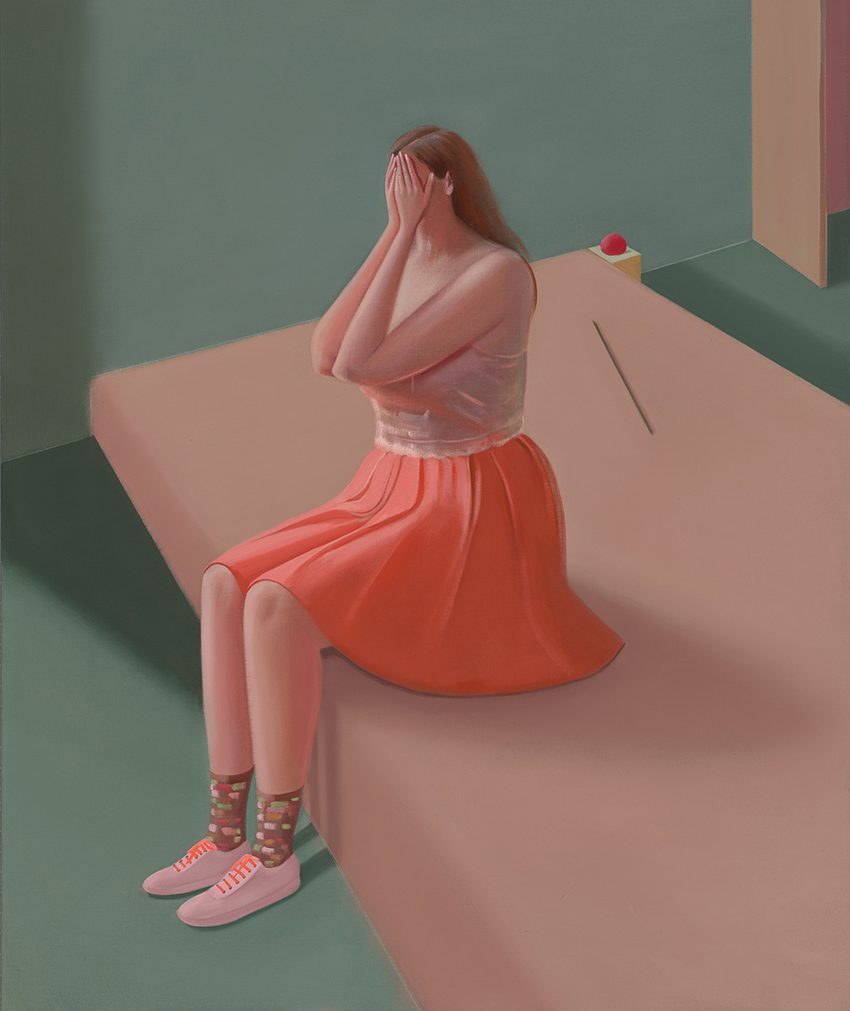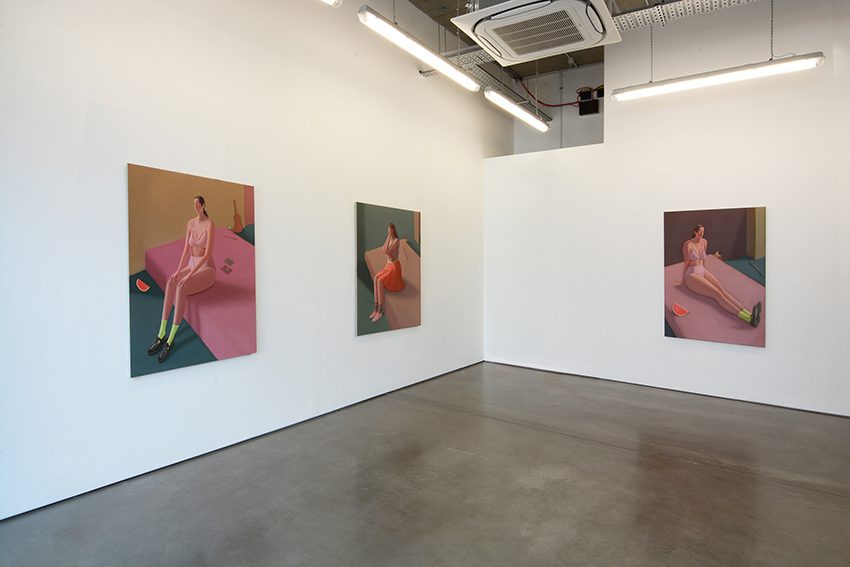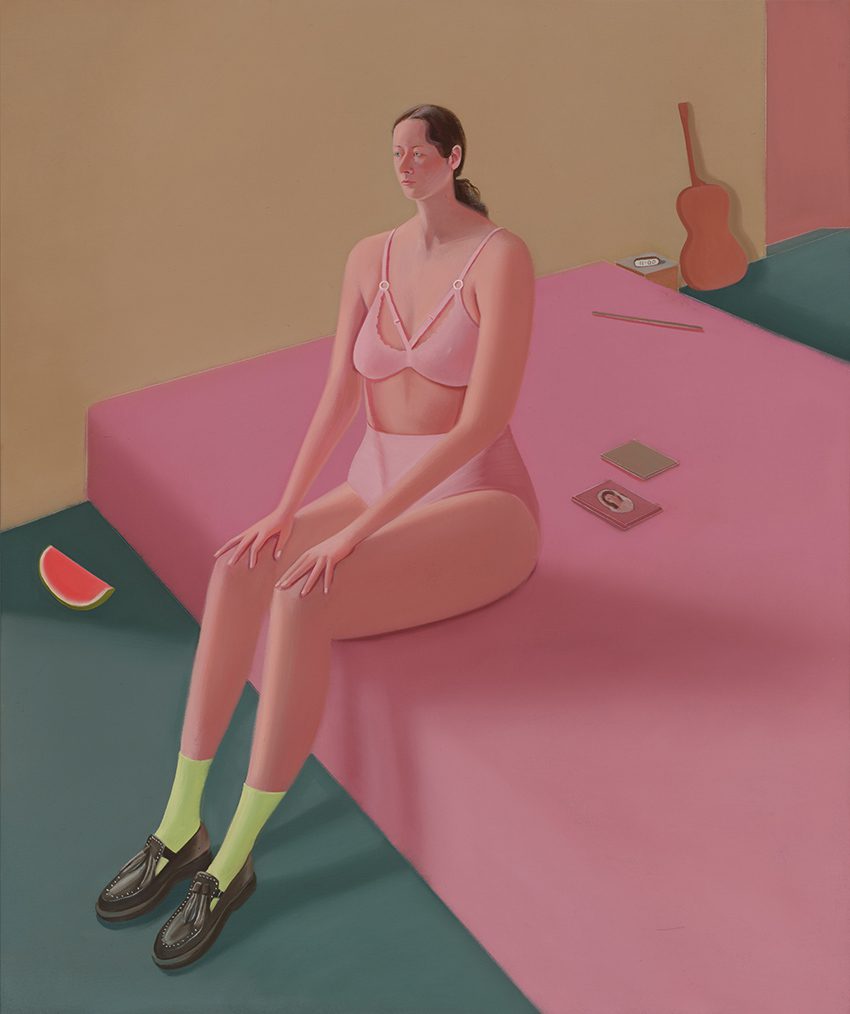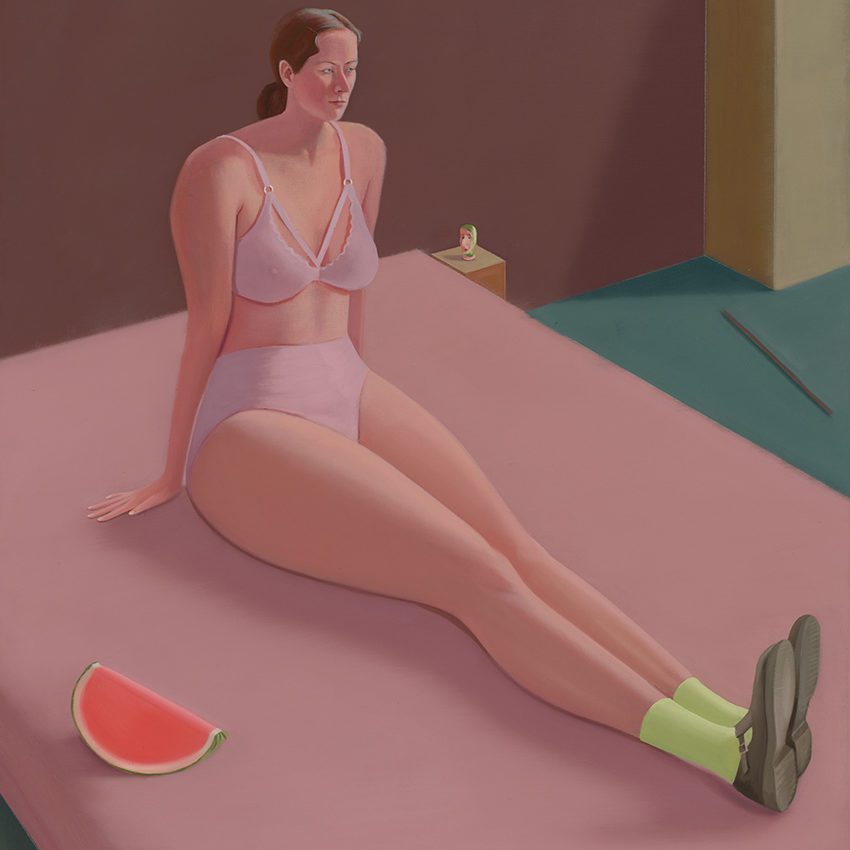Prudence Flint paints women, sometimes in groups more often alone, seated or standing within sparse rooms or landscapes, ostensibly doing very little: just sitting, just standing, just thinking.
In the context of a solo exhibition at Mother’s Tankstation in London, Millie Walton speaks to the artist about painting interior states, the meaning of colour and following her whims.
Let’s start by talking about your process. What’s a typical day in the studio like? Do you follow a particular routine?
I work from home. I have a room with good northern light and high ceilings. The paintings dictate a certain rhythm and pace. I’m often waiting for a passage of paint to dry before I move onto the next stage. I have three paintings hung in my studio at a time. They will have a certain emotional and formal variety and relation to each other. Some paintings happen quickly with enthusiasm. Other work presents an unconscious problem and I need to sit with the work until I work out how to solve it within the formalities of the painting.
Over a year, I finish ten or so paintings. In the studio I rest often and try to follow my whims and be patient. I write for at least an hour a day. I have a red ink pen and I write free form, whatever comes into my head. Sometimes I rant and jump around within topics and give myself permission to say whatever I need to say. It seems to comfort me and serves a purpose.

Have you always painted women?
Yes, that seems to be the reason I paint.
Are the women fictional, people you know, or are they versions of you?
The women in my paintings are fictional. They have their own space, logic and landscape. I stay with the paintings until I feel that they are powerful. Sometimes I am surprised by what happens: how the figure ends up feeling and looking like. I’m sometimes uncomfortable with aspects of the painting and that interests me. Sometimes, after a bit of time, I will look back at a painting and I feel a jolt of recognition… not because of familiarity, but because I see something I couldn’t afford to see or admit at the time. I am other to myself and that is compelling.
Whether the figures are fully or semi dressed, there’s always a fair amount of pink skin on view. How does this reflect your thinking around notions of femininity and the female body?
Looking at the history of western painting the female figure has always been my interest. The nakedness of the women in my paintings is an interior state. At one point I realised that whatever I did regarding dressing or undressing the woman, it would always be full of meaning, loaded and blind.
When it comes to being a woman, sexually, whatever you do, it’s a path, you are caught. It is a kind of an impossible place full of intense activation. Patriarchy will assign you to be diminished through its language of debasement and idolisation. But this offers up a unique opportunity for subversion and perversion.

What’s your relationship to colour?
Colour is coded information. Colour has layers of meaning through history and within different cultures. Pink is the colour of intimacy and watered-down blood. These works speak to my past, growing up a girl in the 60’s and 70’s in the suburbs of Melbourne, Australia. Pink is false promise and violence in denial (the worst kind). It’s the opposite to military blue, or army green.
Although the scenes are familiar, they’re also strange. Why is it important for you to maintain this slight disconnect from reality?
It is a painting after all, with certain limitations, physical demands, requirements, and rules, the presence of surface, edges, and flatness. To find a space to be permissive. The moments where something isn’t right, but it works on another level. I worked for that freedom over a long period of time. I think of it like learning a language. What is reality anyway?

What comes first: the figure or the setting?
I embody the figure first.
The spaces you paint feel quite sparse, but there’s often an object or two such as a piece of fruit or guitar. Are these objects there as clues?
Yes, the objects form the relationships within the painting.
How important is scale?
Scale is like colour, it has layers of meaning, and it’s relational to the body.
What about titles? Your current exhibition, for example, is titled The Call.
I enjoy the titles. I like it best when they bounce off the painting and disrupt the obvious meaning.
Where can we next see your work?
February 2022 at Fine Arts, Sydney – I will be showing five new paintings.
“Prudence Flint: The Call” runs until 27 November 2021 at Mother’s Tankstation, 58-64 Three Colts Lane, Bethnal Green, London. For more information, visit: motherstankstation.com/exhibition/the-call/
Featured Image: Prudence Flint, The Call, 2021. Courtesy the artist and mother’s tankstation Dublin | London

Millie Walton is a London-based art writer and editor. She has contributed a broad range of arts and culture features and interviews to numerous international publications, and collaborated with artists and galleries globally. She also writes fiction and poetry.




















